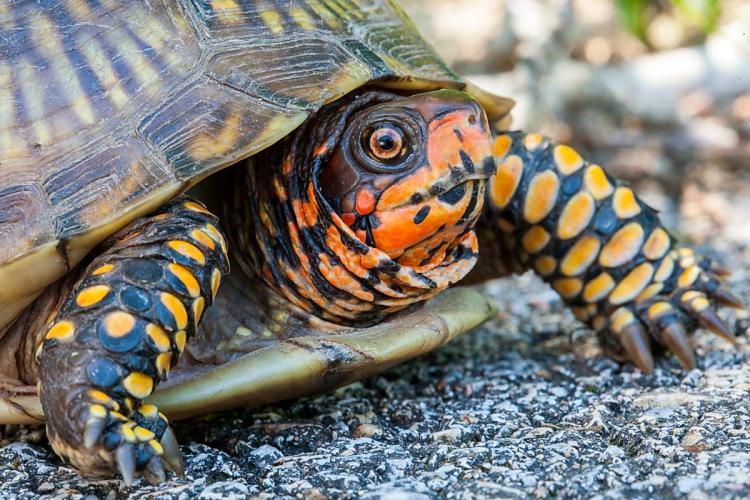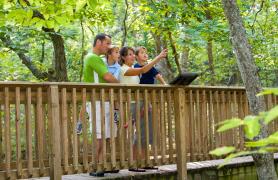It’s spring and wobbly-legged fawns are following their moms through woods and across busy roads. Often this time of year, wild babies get separated from their parents, temporarily or forever. What do you do if you find a wild youngster alone? For a lot of folks, that’s a tough question.
We’re Coded to Care
Babies of all sorts are cute and vulnerable, which explains why we humans can hardly resist taking them in. We are programmed to love and protect them, especially those we perceive to be orphans.
State Wildlife Veterinarian Sherri Russell understands how we feel. “Missourians care about wildlife, and that’s a great thing.” But, she says, most “orphans” aren’t really orphans. “Taking them in keeps them from their parents, who are usually in the woods not far away.”
Bottle-Fed Fawns Become Fearless Bucks
Russell said that adopting wildlife usually ends badly for the animal, the adopter, or both.
Lone fawns in particular are commonly mistaken for orphans. “People find them curled up in the grass, and they think their mother has abandoned them,” Russell said. “In fact, the mother is usually close by, watching you pick up her baby and take it away.”
Once adopted, fawns soon become imprinted on humans, meaning they lose their fear and depend on people for food, water, and shelter. “This makes it impossible for them to be returned to the wild,” Russell said.
Shannon Ohrenberg, one of Greene County’s conservation agents, described a fairly common situation that ends in heartache for both adopters and the agency. Someone takes in a cute little fawn. They bottle feed it and spend time with it. Then, as the deer continues to grow, they open the gate and let it wander free, feeling like they have done the deer a great service. The young buck now has no fear of people. It may walk up and nuzzle people or follow them around. Then the rut occurs, and the “tame” deer starts chasing people around the neighborhood, destroying property, and trying to break through glass doors.
“We obviously end up having to put it down for public safety,” Ohrenberg said. “I just hate this. It makes me really sad.
“For their sake and yours,” she said, “please leave fawns where you find them. In most cases, the mother will come back for them.”
Wild Babies Can Make Your Family Sick
If you’re a Facebook user, you’ve probably seen videos of cute baby raccoons cuddling with kids and pets. These videos get lots of likes, adoring comments, and shares.
Russell is not a fan. “These videos concern me,” she said. “Raccoons carry Baylisascaris procyonis, a kind of gut worm that can infect your dog or your kids. Once inside the victim’s body, it travels to the brain and can cause blindness, coma, or death.”
She explained that the parasite persists in raccoon feces, which can cling indefinitely to surfaces like floors and toys. “Given kids’ tendency to put their hands and toys in their mouths, it’s not hard to see how infection can occur.” She emphasized that no confirmed Baylisascaris infections have ever been reported in Missouri, but more cases have turned up in the last couple of years, especially in the South.
“Most folks really just want to help wildlife however they can,” Russell said. “But they also need to be aware of the risks to themselves and their families when they take wild animals inside their homes.”
What You Can Do to Really Help Wildlife
Like us, wild animals love their freedom. They need plenty of food, appropriate homes, and suitable mates. When things are just right, they find all these in their natural habitat. Most of Missouri’s land is privately owned, so that means wildlife depend on our properties for places to live and raise their young. Wherever you live in the Show-Me State, you can do a little something to help the wildlife stay wild, stay safe, and stay connected to others like them.
Get to know what lives on your land
Your property can be a powerful force for conservation. Your trees harbor songbirds, and your yard or pasture supports a multitude of birds, mammals, and reptiles. If you can, delay mowing and burning until after wildlife have fledged and dispersed. Get to know your wildlife neighbors and avoid disturbing them when they’re breeding and nesting. As Agent Ohrenberg said, “This will save you trying to give inappropriate food to orphaned baby bunnies.”
For more info about Missouri’s natural communities, see Who Lives Near You?
Provide native habitat
Houses, developments, and roads can keep many kinds of wildlife, especially reptiles and amphibians, from finding food, mates, and shelter. It’s hard to connect habitat islands — land that is isolated by development — but you can enrich any available land, such as a backyard or a private roadside, for wildlife like mammals and birds. Planting native trees, shrubs, and wildflowers provides food and natural cover as wildlife go about the business of finding mates and raising families.
What kinds of native trees and plants should you choose? That depends on where in the state you live. In the rolling hills of north Missouri, good choices are trees like oaks and hickories, native grasses like big bluestem and Indian grass, and wildflowers like milkweeds, blazing stars, and coneflowers. If you live in or near historically forested areas, consider a range of hardwoods, understory trees like dogwood and serviceberry, shrubs like spicebush and fragrant sumac, and flowers like celandine poppy, Virginia bluebells, and trillium. If you live along a river or stream, use willows, buttonbush, and sedges to keep banks stable and provide wildlife places to forage, hide, and nest.
For more information about using Missouri’s native plants to enrich wildlife habitat on your rural land, get in touch with your county’s private land conservationist. Visit mdc.mo.gov/contact, or call your regional office. Grow Native!, a program of the Missouri Prairie Foundation, is another great source of information and professional help for using native plants in your home landscape. Visit grownative.org to learn more.
Be careful driving, and give wildlife a brake
In the spring, many wildlife are searching for mates or places to nest. According to Missouri State Herpetologist Jeff Briggler, most of the turtles you see crossing the road in the spring are young male box turtles looking for mates or females looking for places to bury their eggs. He advises giving them a brake if you safely can, and, if it’s safe for you to do so, consider helping them across the road.
“Carry them in the direction they were headed,” Briggler said, “or they may go back to the road.”
Throughout the year, lots of wild animals are active at dawn and dusk. In the morning, night foragers are heading to bed, and wildlife that feed during the day are just waking up and starting to move about. Deer, in particular, are active at dawn and dusk, which explains why so many car-deer accidents happen at these times. If your commute has you driving as the sun rises or sets, be especially cautious. Keep an eye on the ditches and slow down if you see a deer because more are bound to follow.
Don’t attract wildlife close to your home, pets, or livestock
Wildlife, such as deer, rabbits, groundhogs, skunks, squirrels, raccoons, foxes, coyotes, and black bears, are often attracted to our yards and neighborhoods. That’s because they enjoy eating the same things we do. If you garden or feed the birds (or your pets or livestock) near a wooded area, you will attract many of these critters.
To minimize conflicts — which can lead to nuisance control measures, possibly leaving behind vulnerable young — avoid tempting wildlife with food, water, or cover. Fence your garden and beehives, and take in pet food at night. Don’t leave out a greasy, smelly grill, and avoid keeping chickens near the woods. If you feed the birds, consider taking your feeders down from June through October, when they have plenty of native seeds, nuts, fruits, and insects to eat. This will remove temptation from raccoons, deer, bears, and other wildlife.
What’s the difference between habitat and handouts? Native plants and fruits. If it’s meant for your table, pet, or livestock, keep wildlife away from it, if possible.
We can’t be blamed for wanting to rescue wildlife, especially if it seems orphaned or injured. We are, after all, coded to care. But remember that wild animals are wild. They need people, especially in a state like Missouri that’s mostly private land, to learn more about their needs, care for their habitat, and prevent conflicts with them. That’s the kindest care, and it will make us — and them — feel good about sharing the places we call home, all year long.
When to Call an Agent
In most cases, MDC recommends you leave wildlife where you find it. But you should always call your county conservation agent if you find a bald eagle that is dead, injured, or unable to fly. This helps MDC comply with the federal Bald and Golden Eagle Protection Act. For your own safety, DO NOT touch or try to catch a live bald eagle.
Who Lives Near You?
If you’re internet savvy, you have several convenient ways to track the wildlife that lives in your neck of the woods and to learn more about the different kinds of habitat they need to thrive.
First, using apps like iNaturalist.org encourages you to notice nearby wildlife and report sightings of those you care about. For example, the Saint Louis Zoo’s Turtle Road Watch project asks people to use iNaturalist to report sightings of turtles crossing roads. ”Adding observations to the iNaturalist map helps us identify areas of concern,” said Michael Dawson, the zoo’s conservation education liaison. ”Turtles are in serious trouble worldwide, and individual efforts can go a long way toward helping conserve Missouri’s native turtles.”
Another online resource that helps Missourians learn more about the many kinds of natural communities our state’s wildlife depend on is mdc.mo.gov/habitats. Explore this deep well of information, photos, and maps to discover the differences between habitats like forests, woodlands, and glades or fens, wetlands, and marshes. ”It’s the amazing diversity of our state’s natural communities that gives rise to all the different kinds of wild animals and plants that we love to see and enjoy,” said MDC’s Habitat Management Coordinator Nathan Muenks.
Prevent Bird Strikes
An easy way to keep birds from crashing into large windows is to hang simple, lightweight “wind curtains” made of parachute cords in front of them. This dulls reflections and breaks up the illusion of clear passage. Learn more at birdsavers.com/buildyourown-allparacord.html.


















Also In This Issue


And More...
This Issue's Staff
Associate Editor - Bonnie Chasteen
Staff Writer - Larry Archer
Staff Writer - Heather Feeler
Staff Writer - Kristie Hilgedick
Staff Writer - Joe Jerek
Creative Director - Stephanie Thurber
Art Director - Cliff White
Designer - Les Fortenberry
Designer - Marci Porter
Photographer - Noppadol Paothong
Photographer - David Stonner
Circulation - Laura Scheuler






















